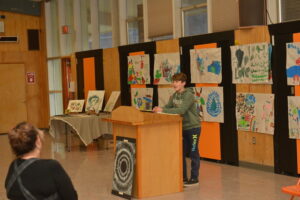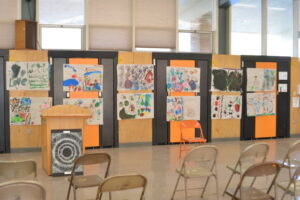
When a disaster hits an area such as it did in Plumas County with the Dixie Fire, the call to action was immediate. The next progression was the focus on recovery, rebuilding and revitalization. The Almanor Foundation stepped up and remains diligent in that mission.
What many did not consider was the emotional scars that can occur . . . and that includes all ages.
Plumas Arts approached The Almanor Foundation Wildfire Fund to help fund from monies raised to put together a program to deal with the emotional aftermath of the youngest victims of Dixie’s wrath – school aged children who had their lives turned upside down. Whether they lost their home, were displaced during the evacuation not knowing what they would return to and then coping daily with the visual destruction of their community and the surrounding area.
With funding granted from TAF, Plumas Arts assembled an art therapy team who made a number of school visits in Indian Valley to include the Plumas Charter School Indian Valley Academy K-12, K-6 Greenville Elementary School and the Greenville High School. The program was designed to assist with the healing process through talking about their experience and expressing their emotions through the arts.
Through these visits, works of art, poetry and writings were created and shared at the Silver Linings Reader’s Theatre (previously called Youth Voices Speaking to Fire). This event showcased the project and what the Indian Valley youth have produced and created in their art therapy workshops
.

Though this was originally designated as a project for the fire trauma, the therapy team soon discovered that students had a good deal to express about their COVID year away from school, the family deaths, pets passing away and abuse and addiction issues in their nuclear family situation due to the enforced isolation.
The therapy team opened up “the arts” to encompass all trauma that students were experiencing rather than contain the topic to only Dixie. Per the therapist, all trauma becomes interlinked in the brain and one thing triggers another. Students may be talking or focusing on one thing, but it can be activated by something else. The team took the approach that Indian Valley is home to many traumas before and after the fire and to be inclusive rather than exclusive when working with the students.
The results of this program were exceptionally healing for the student’s who participated. It also allowed the therapists to make recommendations for follow up with teachers, County Behavioral Health Services and/or Child Protective Services that would have otherwise been left unnoticed. “It was our goal to give the youngest and most vulnerable a forum to ‘get it all out’ in verbal, written and artistic form so that healing can begin,” says Susan Bryner, executive director of The Almanor Foundation. “It also demonstrated how crisis and trauma can be varied and that processing and coping is even more challenging for our youth. It truly is our responsibility to do what we can to ‘make it better’ and was why TAF was supportive of the project and so willing to help fund,” she adds.


